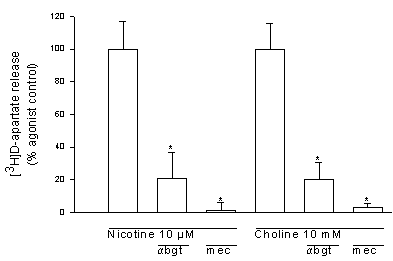| pA2 online © Copyright 2004 The British Pharmacological Society |
072P
University of Bath Summer Meeting July 2004 |
|
The J.A. Dickinson, I.W. Jones, J.N.C. Kew* C. Roberts* & S. Wonnacott. Dept. Biology & Biochemistry, University of Bath, Bath, BA2 7AY and *Psychiatry CEDD, GlaxoSmithKline, Harlow, Essex, CM19 5AW |
|
Presynaptic nicotinic acetylcholine receptors (nAChR) modulate the release of several neurotransmitters, including dopamine and glutamate (Wonnacott, 1997). In this study, the nAChR modulation of [3H]D-aspartate (D-asp) release from prefrontal cortex (PFC) synaptosomes has been pharmacologically characterised using the technique of open-chamber superfusion. D-asp serves as a surrogate for glutamate (Rousseau et al., 2002).
PFC synaptosomes from 2 male Sprague-Dawley rats (250 -350 g) were loaded with 0.2 µM D-asp at 37°C for 15 min. Aliquots were added to superfusion chambers and perfused with Krebs-bicarbonate buffer ± antagonist (0.75 ml min-1) for 24 min to remove excess D-asp before fractions were sequentially collected (2 min fractions). D-asp release was evoked by the application of a nAChR agonist (90 s). Release was calculated as a percentage of the total radioactivity present at the point of stimulation .
Nicotine and the α 7 nAChR selective agonists, choline and AR-R17779, evoked D-asp release in a concentration-dependent manner. Cd2+ (100 µM) blocked nicotine (10 µM) and choline (10 mM)-evoked release by 78.1 ± 3.1% (n=3) and 77.7 ± 11.7% (n=3) respectively, consistent with release by Ca2+-dependent exocytosis. The non-selective nAChR antagonist mecamylamine (20 µM) and ![]() 7 nAChR selective antagonist
7 nAChR selective antagonist ![]() -bungarotoxin ( 40 nM) significantly inhibited nicotine (10 µM) and choline (10 µM)-evoked D-asp release (Figure 1).
-bungarotoxin ( 40 nM) significantly inhibited nicotine (10 µM) and choline (10 µM)-evoked D-asp release (Figure 1).
These data suggest the presence of ![]() 7 nAChR on excitatory amino acid terminals within the rat PFC. This was substantiated by immunocytochemical evidence for the colocalisation of the
7 nAChR on excitatory amino acid terminals within the rat PFC. This was substantiated by immunocytochemical evidence for the colocalisation of the ![]() 7 nAChR with glutamatergic terminals identified by antibodies to the vesicular glutamate transporters 1 and 2.
7 nAChR with glutamatergic terminals identified by antibodies to the vesicular glutamate transporters 1 and 2.

FIGURE 1: [3H]D-aspartate release in response to nAChR agonists, nicotine (n=4) and choline (n=3), in the presence or absence of antagonists, mecamylamine (mec, 20 µM) or ![]() - bungarotoxin ( α bgt, 40 nM). *P<0.05, significantly different from its respective control in the absence of antagonist (Student’s paired t-test).
- bungarotoxin ( α bgt, 40 nM). *P<0.05, significantly different from its respective control in the absence of antagonist (Student’s paired t-test).
Wonnacott S. (1997) Trends Neurosci. 20; 92-98
Rousseau S. J. et al. (2002) BJP ( Proceedings Supplement ) 136; 55P
Supported by BBSRC CASE studentship with GlaxoSmithKline